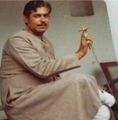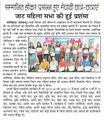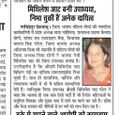Narsinghpur
| Author:Laxman Burdak, IFS (R), Jaipur |
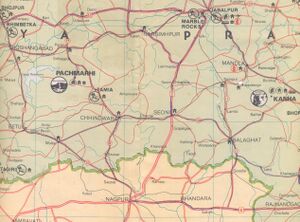
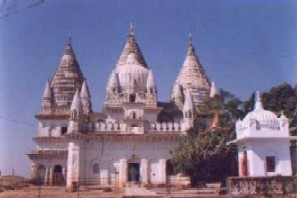
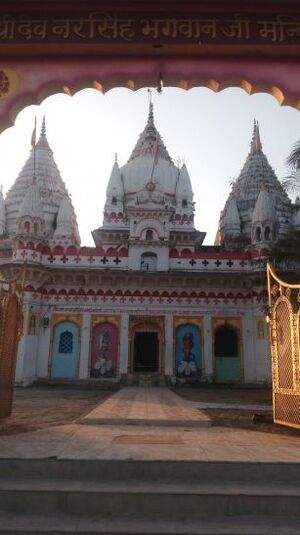
Narsinghpur or Narsimhapur (नरसिंहपुर) is a town in Madhya Pradesh state of central India. Narsinghpur is the administrative headquarters of Narsinghpur District.
Variants
Origin
Jat Gotras Namesake
- Chaura (चौरा) (Jat clan) → Chauragarh (चौरागढ़) is a village and site of a fort in Gadarwara tahsil of Narsinghpur district in Madhya Pradesh.
Tahsils in Narsinghpur district
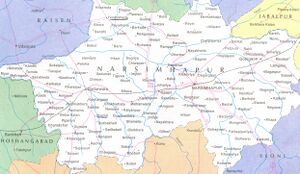
Early History
Narsinghpur district is having many historical Rocks, which are being revered, from time to time during various archeological surveys. According to Gazetteer published by the district in the district of Narsinghpur, about 10 K.M. away from Gadarwara, village called 'Bhatra' certain "Fossil of animals " & apparatus mode of said stones are found during various surveys.During other surveys various ancients monuments & remnant are also found at Devakachhar, Dhubghat, Kumadi, Ratikarar & Bramhanghat. Certain Caves of rocks showing architecture of ancient times are also found at a village called Bijori which is associated with the ancient periods of this district as well as during various service conducted on the banks of river Narmada between BRAMHANGHAT & JHANSIGHAT various "Fossil of animals " & ancients tools are also found showing the Historical & ancient periods of this area. According to historical portraits discovered in this area also beings reaction win periods of Ramayana & Mahabharata. According to reference, Barman-ghat is the place where Lord Bramha had done a Yagya on the sacred banks of river Narmada.
Bilthari gram of block Chanwarpatha was previously known as Balisthali. This place was known as King Bali’s place. According to Puranas during the Mahabharata period, the Pandavas of Satdhara near Barman-ghat, river Narmada's water flow tied up in a single night. It is said that Pandavas had spend some period of their exile at this place, which is confirmed by places like Bhim Kund & Arjun Kund. A Cave near Sankalghat was also associated with Lord Adi Guru Shankracharya's place of meditations & studies.
Village Barhata of this district is a remnant of Virat Nagar of Mahabharata period. Various ancients Structures & Architectural remains found in this village leads to conclusions that this area was part of Mahabharata period. An ancient rock with the shape of human being is related with "Keechak" near village Bachai. The area of Bohani is related with Jasraj father of Alha- Udal & uncle Bachhraj, who were Kings during the period of King Prithavi Raj Chouhan. During the various Historical excavations, various ancients monuments & reference also found which relates this area with ancient periods, exact information about the area is found in history books & Historical Manuscripts from second century AD.
Satavahana Period: During second Century this area was under the rule of Satvahanas. Form 4th century the area was under the Guptas, during which King Samudra Gupta succeed extending the areas of his Kingdom in Central India & Western part of India In 6th Century there are certain indications of padi Kingdom.
But once again History lost in vein for around 300 years. In 9th century Kalchuri Kingdom established here. The Capital of Kalchuri Rajvansh was Mahishmati Nagari near river Narmada which later established at Tripuri. As per the records of history books, Kalchuri Kingdom was expended between Gomati River to Narmada Ghat after fall of Kalchuri, The area was under control of Father & Uncle of Aalha- Udal, who made Bohani as their centre after this during 4th century ,this area was part of Raj Gond Vansh Empire.
Raj Gond Rulers: After the establishment of Raj Gond Vansh an area of piece & prosperity Begins in this area. This Vansh came to existence by Yadav Rao who laid the foundation of a strong Kingdom at a place called Garha - Katanga & started a process of strong mighty rule. One of the rulers Sangram Shah (1400-1541) had established 52 Garh, so strangest the Gond Empire. The fort of Choura Garh (Chougan) at Narsinghpur was constructed by Sangram Shah, which is still an evidence of bravery of Veerarayan . The son of Queen Rani Durgawati.
Among the followers of SANGRAM SHAH, Dalpati shah ruled for a period of 7 years peacefully. After, this Queen Durgawati took the reign, & gave a proof of courage & bravery & ruled for period of 16 years (1540--1564). In year 1564 Queen died, while Fighting bravely, giving tough fight to Asif Khan the Sepoy Salar of King Akbar . In Narsinghpur district at the fort of Chauragarh Asif Khan trapped prince Veer Narayan & killed him by his Cunning tactics. Thus Garha Katanga comes under control of Mugals in the year 1564. Gonds Mugals & after then the area was under control of various officers & administrative & hereditary chiefs during the Maratha’s rule. So, the boundaries of area continued to change according to the powers & influence of their people. Chawarpatha, Barha, Saikheda, Gadarwara, Shahpur, Singhpur,Shrinagar&Tendukheda were headquarters of various parganas.
Bhonsle Rulers: In year 1785, Madhavji Bhonsle purchased the area of Mandla & Narmada ghati in 27 lakhs & area was under pressure of army rule during the reign of Radhoji Bhonsle / Nawab of Bhopal & Pindari' s due to unsuitability & other problems, the common people were extremely exploited. This period also known as period of problems & unsuitability. At last in 1817 British rule came into existence.
Reference - http://narsinghpur.nic.in/history.htm
Jat History
Ram Sarup Joon[1] writes that ....Samudra Gupta conquered the whole of Punjab and a major part of India. The clans defeated by him included
- Malaya who ruled Malva named after their gotra.
- Arjunayana who ruled Mewat and Jaipur;
- Yaudheya whose rule included Bikaner and Bahawalpur;
- Madrak whose capital was Sialkot;
- Abir who ruled Badaun, and the Betwa Basin now called Ahirwara;
- Vir Arjun clan who ruled Narisinghpur;
- Sankanika who territory was present Gwalior;
- Karaskar rule extended into present Mathura, Aligarh (there are 80 villages of these Jats in this area at present) and Kharparika.
Narsinghpur has a large temple of Lord Narsingh known as Narsingh Avatar Temple . This temple was constructed by Jat Sardar in the 18th century, in which Idol of Lord Narsimha placed & worshiped & so in the name of Lord Narsimha. The village Gadariya Kheda where the temple was constructed became "Narsinghpur" after Lord Narsimha & later on it became the headquarter of the district. [2]
The Jat Sardar Rao Jagbharath Ji[3] founder of Narsinghpur was of Khirwar clan. These Jat Sardars were followers of god Narsingh. Here they constructed two temples of Narsingh avatar. Khirwar clan Jats came to this place from Brij and founded the city of Narsinghpur, where they ruled for a long period.[4]
Hukum Singh Panwar[5] has given the ancestry of Bharatpur rulers starting from 1. Yadu. Shini is at S.No. 38 and Krishna at S.No. 43 as under[6]:
34. Andhaka → 35. Bhajmana → 36. Viduratha → 37. Shura → 38. Shini → 39. Bhoja → 40. Hardika → 41. Devamidha → 42. Vasudeva → 43. Krishna → 44. Pradyumna → 45. Aniruddha → 46. Vajra → Khira
Vajra's elder son was Khira. After Vajra the Khira's line is separate from the ancestry of Bharatpur rulers. Khira was the originator of Khirwar Jat clan.
The study of villages near Narmada in Narsinghpur indicates that we have a village named Khireti in Gadarwara tahsil of Narsinghpur district in Madhya Pradesh. Similarly we have another village of the name Khireti in nearby Udaipura tahsil of Raisen District. This region near River Narmada was probably the habitation of King Khir in the fourth generation of Krishna of Mahabharata period. There is a need to search connection of following villages with Khir if any :
- Tahsil Gadarwara - Khairi, Khairi, Khairi, Khairi, Khairi, Khairi, Khairi, Khairi Kalan, Khairi Khurd, Khairua, Kharirua, Khireti, Khiriya, Khiriya,
- Tahsil Gotegaon - Khairi, Khairi,
- Tahsil Kareli: Khairi, Khairi, Khairuwa, Khiriya, Khiriya,
- Tahsil Narsinghpur: Khairi
- Tahsil Tendukheda: Kashi Kheri, Khairi, Khairi, Khairi, Khairi Khurd, Khairuwa, Khairuwa, Khakredi,
- Udaipura Raisen: Kheruya, Khireti, Khiriya,
Rao Sahab Ki Bhakar
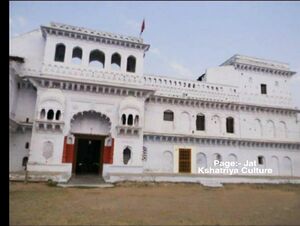
Bhakar or Rao Sahab ki Bhakar was the residence of Rao's of Narsinghpur. The ruler of Narshingpur belonged to Khirwar clan of Jat who came from Braj and settled in the area of Gadariya Khera leadership of Rao Jagbharat Singh. Source - Jat Kshatriya Culture
Narsinghpur District Inscriptions
Source - Hira Lal: Descriptive lists of inscriptions in the Central provinces and Berar,p.61
The district does not contain any important metal or lithic records. In the Town hall at Narsinghpur a number of sculptures are collected. On one of these the name of that ubiquitous Jogi Magaradhaja, with the unvarying accompaniment of the figure 700, is carved. Apparently this stone must have belonged to Barehta, 14 miles from Narsinghpur, which contains perhaps the oldest remains of architecture in the District, a notice of which for the first time seems to have appeared in March 1867 in the Journal of the Antiquarian Society of the Central Provinces.
There are a few lithic records at Barha, Barmhan, Bilahra and Sainkhera, which are more or less illegible. The date on the Bilahra inscription is made out as Samvat 1374 (A.D. 1317).
नरसिंहपुर के जाटों का इतिहास
ठाकुर सत्येन्द्र सिंह[7]ने लिखा है कि 320 वर्ष पूर्व जाटों के दल राजस्थान, हरयाणा, दिल्ली व उत्तर प्रदेश के विभिन्न भागों से ग्वालियर, झांसी व सागर के मार्ग से नरसिंहपुर जिले के क्षेत्र में प्रविष्ट हुए थे। इस काल में पिंडारियों का आतंक था। जाटों ने उनसे संघर्ष किया और खदेड़ दिया। जाटों के उस समय तीन दल आये थे।
- सागर से आगे जाटों का दल गया उसने नरसिंहपुर के आसपास के गाँवों पर कब्ज़ा किया और वहाँ बस गए। जाटों के आगमन के पूर्व नरसिंहपुर का नाम 'गडरिया खेड़ा' था 'गडरिया खेड़ा' पर निवास करते हुए जाटों ने एक विशाल नरसिंह भगवान के मंदिर का निर्माण प्रारम्भ किया। साथ ही एक किलेनुमा गढ़ी का निर्माण कराया। यह गढ़ी वर्त्तमान में राव साहब की बाखर कहलाती है। इस बाखर से दो भूमिगत सुरंगों का निर्माण करवाया जो 'श्री देव नरसिंह भगवान' के मंदिर से जुड़ती हैं। एक सुरंग से जाट राजा, जाट सरदार तथा दूसरी सुरंग से संभ्रांत महिलायें आकर नरसिंह भगवान के दर्शन करती थी, शिव भगवान को अभिषेक करती थी। नरसिंह भगवान का मंदिर 28 वर्षों में पूर्ण हुआ। इस मंदिर के पीछे 18 एकड़ में एक विशाल सरोवर बनाया गया जिसे 'नरसिंह तालाब' के नाम से जाना जाता है। ये सभी निर्माण कार्य पूर्ण होने पर लगभग 285 वर्ष पूर्व नरसिंह भगवान की प्रतिमा विधि-विधान से स्थापित की। इसी दिवस पर गडरिया खेड़ा का नाम नरसिंह भगवान के नाम पर नरसिंहपुर रखा गया।
- नरसिंहपुर जिले में 23 ग्रामों में जाटों का निवास है। ये संपन्न किसान हैं अथवा छोटे-बड़े पदों पर कार्यरत हैं। जाटों का निवास वाले ग्रामों के नाम हैं - बिलहरा, चिचली, धुबघट, गडरिया खेड़ा, गाडरवारा, गोटेगाँव, जल्लापुर , कंदेली, करेली, खैरी, खापा, खुरपा, लोलरी, मेहडा, नरसिंहपुर, साली चौका, तेन्दूखेड़ा ...आदि।
- यहाँ के मुख्य जाट गोत्र हैं - बम्हरौलिया, विडार, ठरऊआ, मामटे, दादाक, कुईया, दासपुरिया, नारोलिया, धौरेलिया, इन्दोलिया, किलेदार,नारा,नौनवार, रावसा, बिसोठिया, दङिया आदि हैं।
- यहाँ के जाटों के नरसिंह भगवान इष्ट देव हैं इसलिए यहाँ के लोग आपस में 'जय नरसिंहजी' कहकर अभिवादन करते हैं।
- राजनैतिक क्षेत्र में नरसिंहपुर जिले में जाटों का विशेष स्थान है। यहाँ के प्रमुख जाट हैं -
- ठाकुर निरंजन सिंह क्रांतिकारी, यहाँ से राज्य सभा सांसद रहे हैं।
- श्री रघुनाथ सिंह किलेदार यहाँ से लोकसभा में संसद रहे हैं।
- राव उदय प्रतापसिंह वर्तमान में सांसद हैं।
- महेंद्र सिंह किलेदार सरकार में मंत्री पद पर रहे हैं। वे कई वर्षों तक विधायक रहे हैं।
- सुरेन्द्र कुमार धौरेलिया विधायक रहे हैं। धौरेलिया कृषि उपज मण्डी अध्यक्ष रहे हैं तथा वे वर्त्तमान में मध्य प्रदेश कृषि मण्डी के संचालक हैं।
जाटों का आखिरी दल महाराष्ट्र के बरार क्षेत्र के जिला अकोला, अमरावती, यवतमाल आदि पहुंचे इन जिलों के अनेक गाँवों में जाटों का निवास है। नागपुर नगर निगम में चौधरी देशराज कई वर्षों महापौर के पद पर आसीन रहे हैं।
सन्दर्भ - जाट-शक्ति, रतलाम, दिनांक 7 मार्च 2014, लेखक: ठाकुर सत्येन्द्र सिंह, तलापर स्कूल के पास, संजयवार्ड, नरसिंहपुर, मो. 09425169149
600 साल पुराना है नरसिंहपुर मंदिर
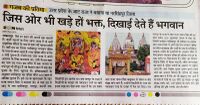
मंदिर के पुजारी प्रमोद कुमार सोनकिया के बताए अनुसार मंदिर करीब 600 साल पुराना है. जाट राजा नाथन सिंह ने इसका निर्माण कराया था. नाथन सिंह यूपी के बुलंदशहर से यहां आए थे. उस समय यहां जंगल ज्यादा था और मानिकपुर से लेकर नागपुर तक पिंडारियों का आतंक था. नागपुर के राजा ने पिंडारियों के सरदार को पकड़कर उनके हवाले करने के लिए भारी इनाम की घोषणा की थी. शरीर से बलिष्ठ और योद्धा नाथन सिंह ने पिंडारियों के सरदार को बंदी बनाकर राजा के सामने पेश किया जिस पर उन्होंने नाथन सिंह को 200 घुड़सवार और 80 गांव इनाम में दिए. जिसके बाद उन्होंने अपने इष्ट नृसिंह देव का मंदिर बनवाया और उन्हीं के नाम पर नरसिंहपुर बसाया गया है. बताया गया कि जिस जगह पर मंदिर बना है वहां पर एक संत अपनी कुटी बनाकर रहते थे. [8]
नोट: जाट समाज के लोगों ने पत्रिका की इस जानकारी को गलत बताया है। इन न्यूजपेपर वालो को नरसिंहपुर के राजपरिवार से संपर्क करने की जरूरत थी। यह लोग भरतपुर व आगरा के निकट से ग्वालियर होते हुए गडरिया खेड़ा पहुचे थे। इनका गोत्र खिरवार है। यहां पीडारियों को मारकर कुलदेव नृसिंह भगवान का मंदिर बनाया इसका नाम नरसिंहपुर रखा। वो शख्स जगभरथ सिंह था ना कि नाथन सिंह। हम ने खुद 2 साल पहले राजपरिवार की सदस्य से बात की थी वो विदेश में रहती है अब। यह क्षेत्र नागपुर के मराठों से कंट्रोल नही हो रहा था। इसलिए ब्रज से गए खेनवार , खिरवार, इन्दोलिया , दुसाद व अन्य गोत्रीय जाटों ने यहां नियंत्रण किया। यह गोत्र बुलंदशहर जिले में निवास नही करते हैं। राव उदय प्रताप सिंह इन्दोलिया यहाँ से लगातर सांसद बन रहे हैं|
Villages in Narsinghpur Tahsil
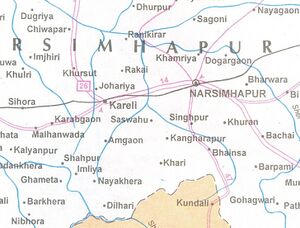
Agariya, Alod, Amapani, Amoda, Andiya, Babariya, Bachai, Badguwan, Badguwan (Badgaon), Bagpaundi, Bahadurpur, Bahoripar, Bahoripar, Bakori, Bamhani, Bamhori, Bamhori, Bandhi, Bandroha, Banskuari, Bargi, Barkheda, Barpani, Barurewa, Barurewa (Murgakheda), Beharpaundi, Belkheda, Bhainsa, Bhalpani, Bhandardeo, Bharwara, Bhoori Khoh, Bhoot Pipariya, Bhouti, Bichhua (Pithehara), Bichua, Bijauri, Bildha, Boriya, Budhaina, Chandpura, Char Baheriya, Chawarpatha, Chilachon Kalan, Chilachon Khurd, Chourakheda, Dangidhana, Deonagar, Deori Kalan, Dhamna, Dhana, Dhana (Mehka), Dhariya, Dhawai, Dhedwara (Dethwara), Dhubghat, Dhubghat, Dokarghat, Dongargaon, Dongargaon (Jotkheda), Dudwara, Dundi Pindrai, Dungariya, Dungariya, Dungariya, Durajpur, Gadariya, Gadariya Kheda, Gangai, Gararu, Gargata, Ghat Pipariya, Ghatpindrai, Ghoghra, Ghughri, Gohgawari, Gorakhpur, Gotegaon, Gour Chhapar, Gudwara, Gutori, Gwari, Hadikat, Hanumat Pondi, Hirapur, Imaliya, Jaitpur, Jamuniya, Jamunjhiriya, Jarjola, Jatlapur, Jera, Jhagarhai, Jhamar, Jharkhurpa, Jhilpini, Jhiri Kalan, Jhiri Khurd, Jotkheda, Kalyanpur, Kana Udal, Kandeli, Kanharpani, Karhaiya, Karhaiya, Karhaiya, Karhaiya Kheda, Kathautiya (A), Kathautiya (B), Katkuti, Kenkara, Khairi, Khamariya, Khamariya, Khamariya, Khamtara, Khapa, Khapa, Khapa, Khurpa, Kislai, Koda, Kodras Kalan, Kodras Khurd, Kodsa, Kukwara, Kurela, Laberi, Lidhari, Lokipar, Lurehta, Machwara, Madh Pipariya, Magardha, Mahguwan, Mahmadpur, Malah Pipariya, Malhaua, Malkuhi, Mandwa, Mehgaon (Mehgawan), Mehka (Dhana), Mehka (Khapa), Mudiya, Mundrai Kalan, Mungwani, Murachh, Murgakheda, Murli Pondi, Naktuwa, Nandwara, Nariya, Narsimhapur, Narsimhapur (M), Nawalgaon, Nayagaon, Nayakheda, Nayakheda, Pala, Pala Mundrai (Khurd), Panjra, Panjra, Pansi, Parasthana, Pataniya, Patha Pipariya, Pindrai, Pipariya, Piparpani, Pithehara (Bandhi), Rani Pindrai, Rani Pipariya, Ratomati, Rohni, Ronsara, Sagouni Kalan, Sagouni Kalan (Chaudhari), Sagouni Khurd, Sagouni Khurd, Sahajpura, Salaiya, Salaiya, Saliwada, Samnapur, Sarra, Sawalrani, Semra, Shyamkheda, Sihora, Simariya, Simariya, Singhpur, Singodi, Singrampur, Sukha, Supla, Surajgaon, Thuhari Kalan, Tindani, Tindani, Usari, Vikram Nagar, Vikrampur,
Jat Gotras
Jat Gotras in Narsinghpur district are:
- Bamraulia
- Bidar
- Bisothia
- Dandak
- Daria
- Dashpuria
- Dhaureliya
- Dhorelia
- Indolia
- Khirwar
- Kiledar
- Nara
- Narolia
- Naunwar
- Tharua
Notable Jats/persons from Narsinghpur
- Rao Jagbharath Ji - Khirwar Jat Sardar founder of Narsinghpur
- Rao Uday Pratap Singh (Indolia) - M P from Lok Sabha seat Hoshangabad. Rao Uday Prartap Singh had won the Assembly seat for the first time in December 2008. He had won the Lok Sabha seat also for the first time from Hoshangabad in 15th Loksabha elections. He is from village Lolaria (लोलरिया) in Tendukheda tahsil in Narsinghpur district in Madhya Pradesh.
- Raghu Nath Singh Kiledar - M P Lok Sabha
- Thakur Niranjan Singh: After the establishment of Indian National Congress in the year 1885, in this district the feeling for Independence was prevalant and strong efforts were made by the people here to gain independence from the British.Being motivated by the efforts under the leadership of Lokmanya Tilak,Subhash Chandra Bose, Mahatma Gandhi and Pandit Jawahar Lal Nehru people joined freedom movement. Among the leaders of this district were Gayadutt, Manik Chand Kochar, Choudhary Shankar Lal ,Thakur Niranjan Singh and Sri Shyam Sunder Narayan Musharan who lead the people of this district towards the Independence movements. In a bid to break the unity and enthusiasm of the people, the British, once again partitioned the district and merged it with Hoshangabad district but even then, enthusiasm as well as fight for independence continued in the minds of the people. During the mass demonstration of satyagrah at Chichli in the year 1932 Mansharam and Gauradevi lost their lives during Police firing.[9]
- Thousands of revolutionaries faced the atrocities of British rule and gave an example of strong devotion for the country and snipe against the British rule. When country got Independence in the year 1947 on 15th August, a new era started in the history of this district. After 9 years of Independence when states were reorganized on the basis of languages, Narsinghpur, once again, became district. Since 1st November 1956, Narsinghpur district has been moving towards progress and prosperity.
- Rao Raj Kishor Singh (Khirwar) (Mob:7792230719)
- Sant Singh (Mohan Bhai) - Ex. Parshad Kisani Mohalla, Narsinghpur, Mob: 9617557564, 9425857994
- Lal Sahab Jat - Sachiv Jat Mahasabha Narsinghpur, Bypass Charaha, Chhindwara Road, Mob: 9425168652
- Madhvendra Singh (Mechanical) (Gotra - Durwasa) Retd HAL , Settled in Nashik, Home district - Narsinghpur, M.P. (9422707303)
- श्रीमती मिथलेश जाट पत्नि डाक्टर डी एस जाट - आप जाट समाज की अत्यन्त सक्रिय कार्यकर्ता हैं । जाट समाज महिला मंडल की अध्यक्ष हैं । आपके नेतृत्व में जाट समाज में समय समय पर कार्यक्रम आयोजित होते रहते हैं । आप भाजपा महिला मोर्चा जिला नरसिंहपुर की उपाध्यक्ष हैं । आपका एक बेटा और एक बेटी हैं । श्रीमती जाट दहेज प्रथा की विरोधी है । आपने अपने बेटे के विवाह में किसी भी प्रकार का दहेज़ स्वीकार न कर क्षेत्र में एक उदाहरण प्रस्तुत किया है । वर्तमान में ये फरमान, नरसिंहपुर में निवासरत हैं । इनका संपर्क नंबर 9826896233 है ।
External links
- Jat Samaj, Agra : April 2000
- http://narsinghpur.nic.in/research.htm
Gallery
-
Rao Raja Raj Kishore Singh Khirwar of Narsinghpur
-
District map of Narsimhapur
-
Raja Raj Kishor Singh Khirwar Raja of Narsinghpur, Madhya Pradesh, Source - Jat Kshatriya Culture
-
-
-
-
-
होली मिलन समारोह के अवसर पर स्वतंत्रता-संग्राम सेनानी स्व. श्री ठाकुर निरंजन सिंह की सुपुत्री श्रीमती दीप्ति प्रभा नारोलिया पत्नि स्व.श्री अनिरुद्ध सिंह नारोलिया का सम्मान करते हुए श्रीमती मिथलेश जाट
References
- ↑ History of the Jats/Chapter IV ,p. 58
- ↑ http://narsinghpur.nic.in/history.htm
- ↑ Jat History Dalip Singh Ahlawat/Chapter XI, p. 1024, कविराज योगेन्द्र शास्त्री:'जाट इतिहास' पृ. 288
- ↑ Jat Samaj, Agra : April 2000
- ↑ The Jats:Their Origin, Antiquity and Migrations/Appendices/Appendix No.1
- ↑ Yadu Vamsavali of Bharatpur given by Ganga Singh in his book 'Yadu Vamsa', Part 1, Bharatpur Rajvansa Ka Itihas (1637-1768), Bharatpur, 1967, pp. 19-21
- ↑ जाट-शक्ति, रतलाम, दिनांक 7 मार्च 2014, लेखक: ठाकुर सत्येन्द्र सिंह, तलापर स्कूल के पास, संजयवार्ड, नरसिंहपुर, मो. 09425169149
- ↑ पत्रिका में अजय खरे का लेख, 16.12.2016
- ↑ http://narsinghpur.nic.in/history.htm
- ↑ Jat Vaibhav Smarika Khategaon, 2010, p. 36
- ↑ Jat Vaibhav Smarika Khategaon, 2010, p. 50
- ↑ Jat Vaibhav Smarika Khategaon, 2010, p. 150
Back to Places




